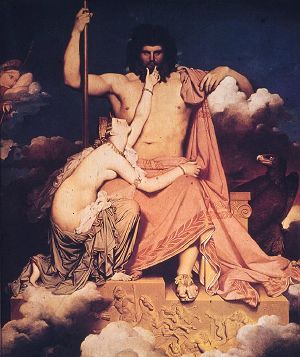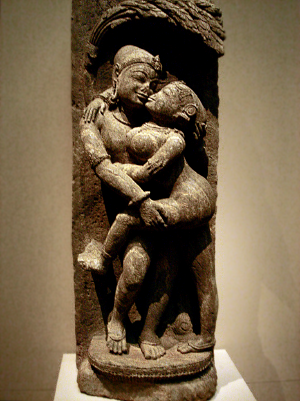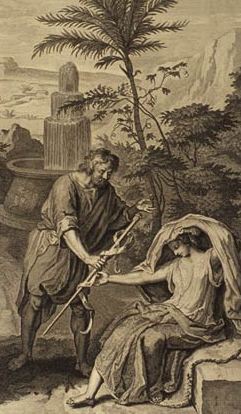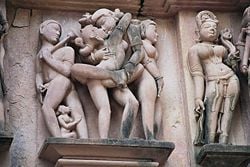Hieros gamos
Hieros Gamos (Greek ιερός γάμος, "sacred wedding") or Hierogamy refers to the coupling of a god and goddess or their earthly representatives, often having a symbolic meaning related to fertility and generally conducted in the spring.
The concept of the hieros gamos derives from ancient mythologies relating to the marriage of the first diety and his or her consort(s). In terms of the ritual expression of this idea, the heavenly marriage historically took three forms: a) the union of a god and goddess as expressed in various art forms; b) the union of a goddess and a priest or king standing in the role of the god; and c) the union of a god and priestess standing for the goddess. The tradition of heiros gamos was usually performed in argricultural societies where these unions were understood to bring fertility to the land, especially in the Middle East. The priestess or priest could also stand for the deity in relationship to citizens or travelers in the practice of "sacred harlotry."
The formal ritual sometimes, but not always, involved actual sexual intercourse. Documented examples normally involved a public procession, an exchange of gifts, the purification of the couple enacted the ceremony, a wedding feast, the preparation of the marriage chamber, and an act of intercourse, either actual or symbolic. A festival on the following morning often celebrated the blessings brought to the community as a result: the union of heaven and earth resulting in the continuity of life's cycle of rain, fertility, procreation, and abudnance.
Historical examples
Mesopatamia
The ancient creation myth Enuma Elish begins with a desription of the generation of the cosmos through the co-mingling of the "waters" of heaven and earth in the persons of the male deity Apsu, and the sea-goddess Tiamat. The union of Apsu's fresh water with Tiamat's salt water spawned both the gods and civiliation.
- When on high the heaven had not been named,
- Firm ground below had not been called by name,
- When primordial Apsu, their begetter,
- And Mummu-Tiamat, she who bore them all,
- Their waters mingled as a single body,
- No reed hut had sprung forth, no marshland had appeared,
- None of the gods had been brought into being,
- And none bore a name, and no destinies determined—
- Then it was that the gods were formed in the midst of heaven.
The world's oldest epic poem, the Epic of Gilgamesh, evidences a culture in which the hieros gamos was a well established practice and sexual union with the priestesses of the goddess Ishtar was seen as a civilizing function. When Gilgamesh discovers his nemesis, the wild man Enkidu, his strategy for civilizing him is to send Shamhat, the priestess-harlot of Ishtar, to teach Enkidu how to live as a cultured human being. She uses her feminine charms to seduce him into a week-long sexual initiation and teaches him the ways of civilized men.
The sacred marriage of the king of a Sumerian city-state and the High Priestess of Inanna, is also attested in several other historical sources.
In Canaan
The hieros gamos in ancient Canaan seems to have been generally inherited from its older Mesopotamian counterpats. In the Urgaritic literature, the god Baal was the diety of rain and storm, and thus fertility for crops. Through the help of his sister Anat, he proves victorious over Mot, the desert god of dryness and death. Anat, the ever-virgin goddess of dew and war, joins with him and gives birth to a sacred bull, which she presents to him at Mount Saphon. While human enactments of the hieros gamos in Canaan are not attested by the Canaanite sources themselves, they are normally inferred by Hebrew accounts, which refer then frequently in opposition.
Hierogamy in the Hebrew Bible
Modern scholars such as Joseph Campbell hold that the creation of story of the Book of Genesis represents a retelling of the Enuma Elish creation myth. Here, the vision of Aspu and Tiamat's coupling is condensed into the formula:
Now the earth was formless and empty, darkness was over the surface of the deep, and the Spirit of God was hovering over the waters. (Gen 1:2)
In this view, the Mesopotamian vision of the marriage between heaven (God) and eath (the salt-water ocean) was inherited by the early Hebrews, who paticipated in hieros gamos rituals until at least the time of the Babylonian exile. The first instance of this concerns the patriach Judah in the Book of Genesis. Judah, whose lineage is about to expire, goes to the town of Timnah for a spring sheep-shearing festival, where he has sexual relations with a vieled sacred harlot near the town gate. The woman is actually his daughter-in-law Tamar, who bears him twin sons that become the foreathers of the Tribe of Judah.
Later, such practices were strongly condemned by the prophets and writers of biblical histories. Deuteronomy 23:17 forbids the practice which Tamar imitated, saying: "No Israelite man or woman is to become a shrine prostitute." The prophet Jeremiah complained: "Have you seen what faithless Israel has done? She has gone up on every high hill and under every spreading tree and has committed adultery there." (Jeremiah 3:6)
The Books of Kings refer to male shrine prostitutes as common in the Kingdom fo Judah as early as the days of King Rehoboam (tenth century B.C.E.) and as late as King Josiah (late seventh century B.C.E.): "He (Josiah) also tore down the quarters of the male shrine prostitutes, which were in the temple of the Lord and where women did weaving for Asherah." 2 Kings 23:7
Gnostic examples
In Tantric Yoga
Several sexual rituals are recommended and practised. These involve elaborate and meticulous preparatory and purificatory rites. The act balances energies coursing within the pranic ida and pingala channels in the subtle bodies of both participants. The sushumna nadi is awakened and kundalini rises upwards within it. This eventually culminates in samadhi wherein the respective individualities of each of the participants are completely dissolved in the unity of cosmic consciousness. Tantrics understand the act on multiple levels. The male and female participants are conjoined physically and represent Shiva and Shakti, the male and female principles. Beyond the physical, a subtle fusion of Shiva and Shakti energies takes place resulting in a united energy field. On an individual level, each participant experiences a fusion of their own Shiva and Shakti energies.
Modern examples
A possible modern example of hierogamy is in the religion of Wicca, in which participants engage in what is called the Great Rite. Most often done on Beltane night (May 1), a man and a woman, assuming the identities of God and Goddess, engage in sexual intercourse to celebrate the union of the deities as lovers and the conception of the new God who will be born at Yule. It is essentially a fertility rite, meant to symbolize the planting of seed into Mother Earth, which will come to fruition in the autumn.
It is furthermore one of the themes that Carl Jung dealt with, in his book Symbols of Transformation.
Influence
Hieros Gamos-like rituals provide controversial scenes in Stanley Kubrick's movie Eyes Wide Shut, in the novel Harvest Home by Tom Tryon and in the Dan Brown novel and Ron Howard film The Da Vinci Code.
See also
- Sex magic
- Tantra
- Religious prostitution
Notes
ReferencesISBN links support NWE through referral fees
External links
- The Hierosgamos Theme in the Images of the Rosarium Philosophorum, Karen-Claire Voss
- Ivory statuette of hieros gamos (found at Delphi)
- Sculptural relief of hieros gamos from a temple to Hera in Sicily
- Sculptural relief of hieros gamos from Parthenon (temple of Athene) at Athens
- Wall-painting of hieros gamos from Roman period Pompeii
Credits
New World Encyclopedia writers and editors rewrote and completed the Wikipedia article in accordance with New World Encyclopedia standards. This article abides by terms of the Creative Commons CC-by-sa 3.0 License (CC-by-sa), which may be used and disseminated with proper attribution. Credit is due under the terms of this license that can reference both the New World Encyclopedia contributors and the selfless volunteer contributors of the Wikimedia Foundation. To cite this article click here for a list of acceptable citing formats.The history of earlier contributions by wikipedians is accessible to researchers here:
The history of this article since it was imported to New World Encyclopedia:
Note: Some restrictions may apply to use of individual images which are separately licensed.



